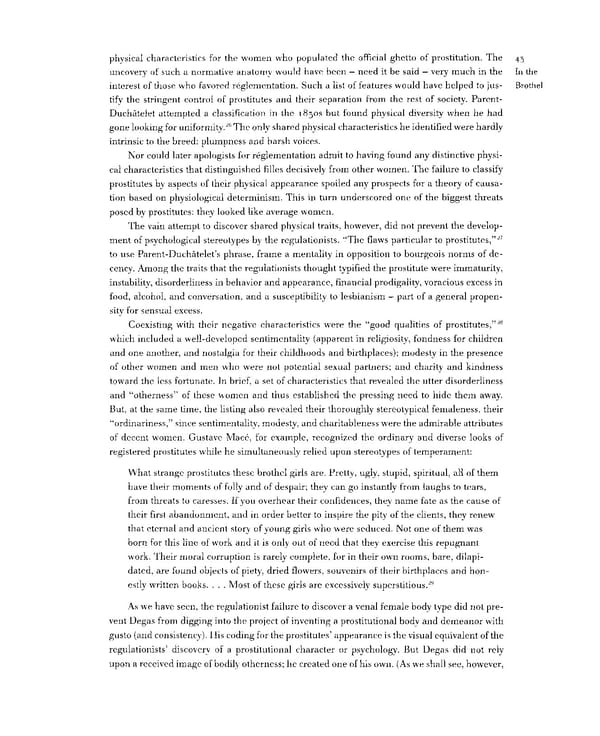physical characteristics for the women who populated the official ghetto of prostitution. The 43 uncovery of such a normative anatomy would have been — need it be said — very much in the In the interest of those who favored reglementation. Such a list of features would have helped to jus- Brothel tify the stringent control of prostitutes and their separation from the rest of society. Parent- Duchatelet attempted a classification in the 18308 but found physical diversity when he had 26 gone looking for uniformity. The only shared physical characteristics he identified were hardly intrinsic to the breed: plumpness and harsh voices. Nor could later apologists for reglementation admit to having found any distinctive physi- cal characteristics that distinguished filles decisively from other women. The failure to classify prostitutes by aspects of their physical appearance spoiled any prospects for a theory of causa- tion based on physiological determinism. This in turn underscored one of the biggest threats posed by prostitutes: they looked like average women. The vain attempt to discover shared physical traits, however, did not prevent the develop- 2 ment of psychological stereotypes by the regulationists. "The flaws particular to prostitutes," 7 to use Parent-Duchatelet's phrase, frame a mentality in opposition to bourgeois norms of de- cency. Among the traits that the regulationists thought typified the prostitute were immaturity, instability, disorderliness in behavior and appearance, financial prodigality, voracious excess in food, alcohol, and conversation, and a susceptibility to lesbianism — part of a general propen- sity for sensual excess. Coexisting with their negative characteristics were the "good qualities of prostitutes,"28 which included a well-developed sentimentality (apparent in religiosity, fondness for children and one another, and nostalgia for their childhoods and birthplaces); modesty in the presence of other women and men who were not potential sexual partners; and charity and kindness toward the less fortunate. In brief, a set of characteristics that revealed the utter disorderliness and "otherness" of these women and thus established the pressing need to hide them away. But, at the same time, the listing also revealed their thoroughly stereotypical femaleness, their "ordinariness," since sentimentality, modesty, and charitableness were the admirable attributes of decent women. Gustave Mace, for example, recognized the ordinary and diverse looks of registered prostitutes while he simultaneously relied upon stereotypes of temperament: What strange prostitutes these brothel girls are. Pretty, ugly, stupid, spiritual, all of them have their moments of folly and of despair; they can go instantly from laughs to tears, from threats to caresses. If you overhear their confidences, they name fate as the cause of their first abandonment, and in order better to inspire the pity of the clients, they renew that eternal and ancient story of young girls who were seduced. Not one of them was born for this line of work and it is only out of need that they exercise this repugnant work. Their moral corruption is rarely complete, for in their own rooms, bare, dilapi- dated, are found objects of piety, dried flowers, souvenirs of their birthplaces and hon- 29 estly written books. . . . Most of these girls are excessively superstitious. As we have seen, the regulationist failure to discover a venal female body type did not pre- vent Degas from digging into the project of inventing a prostitutional body and demeanor with gusto (and consistency). His coding for the prostitutes' appearance is the visual equivalent of the regulationists' discovery of a prostitutional character or psychology. But Degas did not rely upon a received image of bodily otherness; he created one of his own. (As we shall see, however,
 Prostitution & Impressionists Page 63 Page 65
Prostitution & Impressionists Page 63 Page 65